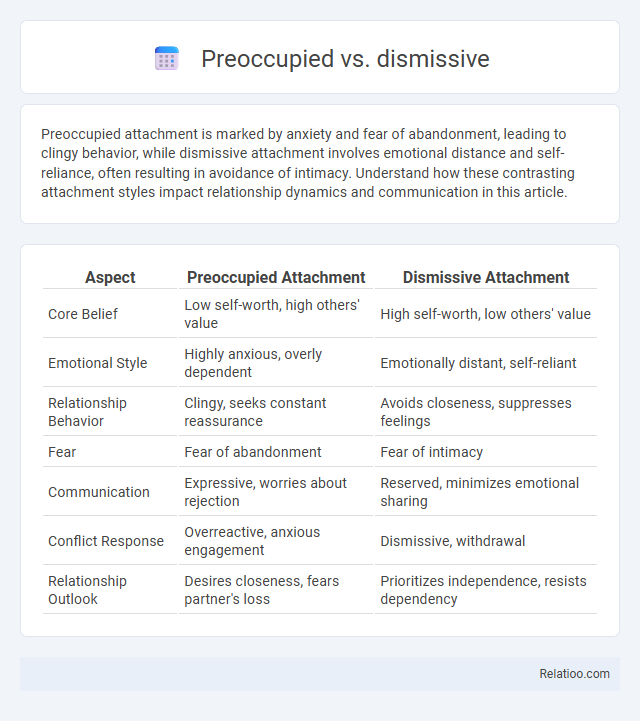Preoccupied attachment is marked by anxiety and fear of abandonment, leading to clingy behavior, while dismissive attachment involves emotional distance and self-reliance, often resulting in avoidance of intimacy. Understand how these contrasting attachment styles impact relationship dynamics and communication in this article.
Table of Comparison
| Aspect | Preoccupied Attachment | Dismissive Attachment |
|---|---|---|
| Core Belief | Low self-worth, high others' value | High self-worth, low others' value |
| Emotional Style | Highly anxious, overly dependent | Emotionally distant, self-reliant |
| Relationship Behavior | Clingy, seeks constant reassurance | Avoids closeness, suppresses feelings |
| Fear | Fear of abandonment | Fear of intimacy |
| Communication | Expressive, worries about rejection | Reserved, minimizes emotional sharing |
| Conflict Response | Overreactive, anxious engagement | Dismissive, withdrawal |
| Relationship Outlook | Desires closeness, fears partner's loss | Prioritizes independence, resists dependency |
Understanding Attachment Styles: Preoccupied vs Dismissive
Understanding attachment styles reveals that preoccupied individuals often seek high levels of intimacy and approval, displaying anxiety about abandonment and heightened sensitivity to relationship dynamics. Dismissive types tend to maintain emotional distance, prioritize independence, and suppress attachment needs, often appearing aloof or uninterested in closeness. Recognizing these contrasting behaviors helps in addressing relational challenges by fostering communication strategies tailored to emotional expression and security needs.
Defining Preoccupied Attachment
Preoccupied attachment is characterized by a heightened need for approval and fear of abandonment, causing individuals to seek constant reassurance in relationships. You may experience intense emotions and difficulty trusting others, often leading to clinginess and dependence. Unlike dismissive attachment, which involves emotional detachment, preoccupied attachment focuses on anxiety and hyper-awareness of relational dynamics.
Characteristics of Dismissive Attachment
Dismissive attachment is characterized by emotional distance, self-reliance, and avoidance of intimacy, often resulting in difficulty trusting others or expressing vulnerability. Individuals with dismissive attachment may downplay the importance of relationships and prioritize independence, sometimes leading to a reluctance to seek support or acknowledge emotional needs. This attachment style commonly originates from early experiences of neglect or rejection, influencing adult relationship dynamics marked by detachment and a preference for solitude.
Core Differences Between Preoccupied and Dismissive Styles
Preoccupied attachment style is characterized by anxiety and a strong desire for closeness, often leading to clinginess and fear of abandonment, whereas dismissive attachment involves emotional distance and a preference for independence, minimizing the importance of relationships. Your preoccupied tendencies drive you to seek constant reassurance and validation, while dismissive individuals suppress emotional needs and avoid intimacy. Understanding these core differences helps in navigating relationship dynamics and fostering healthier emotional connections.
Emotional Patterns in Preoccupied Individuals
Preoccupied individuals exhibit intense emotional patterns characterized by a strong desire for closeness paired with anxiety about abandonment, leading to heightened sensitivity in relationships. Their emotional regulation often fluctuates, causing them to feel overwhelmed by perceived rejection or lack of attention from significant others. Understanding your own emotional patterns can help you manage these reactions and foster healthier interpersonal connections.
Behavioral Traits of Dismissive People
Dismissive people often exhibit behavioral traits characterized by emotional distance, reluctance to depend on others, and a preference for self-reliance. They tend to downplay the importance of close relationships, showing discomfort with intimacy and vulnerability. Their avoidance of emotional closeness frequently leads to a detached and reserved demeanor in social interactions.
Relationship Impact: Preoccupied vs Dismissive Attachment
Preoccupied attachment often leads to intense emotional dependence and fear of abandonment, causing frequent conflicts and emotional exhaustion in relationships. Dismissive attachment, characterized by emotional distancing and self-reliance, results in avoidance of intimacy and difficulty expressing feelings, creating barriers to deep connection. These contrasting styles lead to a push-pull dynamic where the preoccupied partner's need for closeness clashes with the dismissive partner's desire for independence, significantly impacting relationship stability and satisfaction.
Communication Styles and Conflict Management
Preoccupied individuals exhibit an anxious communication style, frequently seeking reassurance and displaying high emotional expressiveness, which can lead to conflict through perceived dependence or neediness. Dismissive communicators maintain emotional distance, often minimizing issues and avoiding vulnerability, resulting in conflict management characterized by withdrawal or denial. Managing conflict effectively requires recognizing these patterns: preoccupied styles benefit from validation and clear boundaries, while dismissive styles improve through gradual trust-building and open dialogue.
Healing and Growth: Coping Strategies for Each Style
Healing from attachment styles involves tailored coping strategies that address the unique challenges of preoccupied, dismissive, and fearful-avoidant patterns. Preoccupied individuals benefit from building self-worth through affirmations and mindfulness practices that reduce anxiety in relationships. Dismissive types heal by fostering vulnerability and practicing emotional openness, while fearful-avoidant individuals find growth by integrating self-compassion with gradual exposure to intimacy, enhancing trust and security.
When Preoccupied Meets Dismissive in Relationships
When Preoccupied meets Dismissive in relationships, emotional needs often clash as the Preoccupied partner seeks closeness while the Dismissive partner values independence and detachment. You may experience frustration due to differing attachment styles, where Preoccupied individuals pursue reassurance and Dismissive individuals avoid intimacy. Understanding these dynamics is crucial for fostering communication and balancing connection with personal space.

Infographic: Preoccupied vs Dismissive
 relatioo.com
relatioo.com